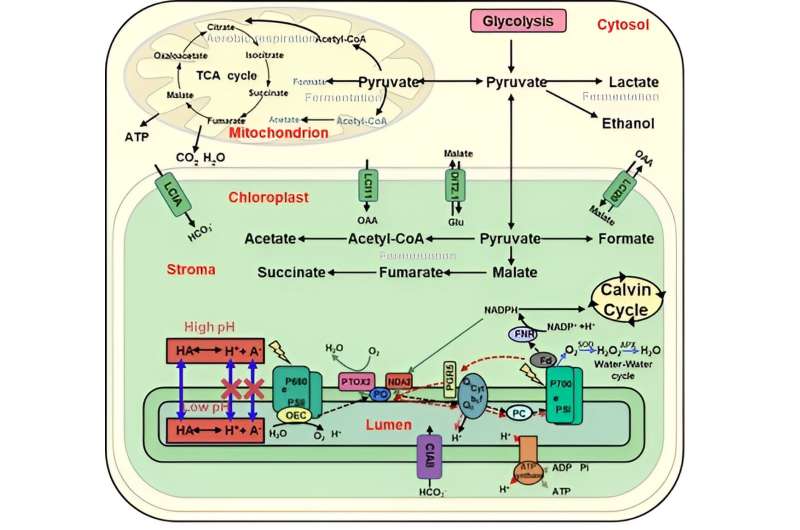This article has been reviewed according to Science X's editorial process and policies. Editors have highlighted the following attributes while ensuring the content's credibility:
fact-checked
peer-reviewed publication
trusted source
proofread
Study shows anaerobic fermentation metabolites suppress both photosynthesis and aerobic respiration

In the model organism Chlamydomonas reinhardtii, photosynthesis and aerobic respiration take place in chloroplasts and mitochondria, respectively, while anaerobic fermentation can occur independently in the cytoplasm, mitochondria, and chloroplasts. How these three fundamental energy metabolism processes can occur in harmony within a single cell remains largely unexplored.
A research team led by Prof. Tian Lijin from the Institute of Botany of the Chinese Academy of Sciences (IBCAS) found that anaerobic fermentation metabolites suppress both photosynthesis and aerobic respiration. Their study was published in Nature Communications.
Previous studies have shown that photosynthetic organisms gradually accumulate protons under dark treatment, leading to acidification of the thylakoid lumen and consequent inhibition of photosynthesis, which has been tentatively attributed to either chlororespiration or ATP hydrolysis. However, the researchers ruled out these explanations respectively by using mutants lacking the relevant gene.
In this study, considering that long-term dark adaptation of the concentrated cell can lead to anoxia and thus trigger acidic fermentation, the researchers thus speculated that the weak acids produced during the fermentation process could have inhibited photosynthesis.
To verify this idea, they showed that the degree of lumen acidification was positively correlated with the total accumulation of weak acids produced by the fermentation, whereas no acidification was detected in the green alga NIES-2499, which does not produce weak acids during fermentation metabolism.
This demonstrated that fermentation is responsible for lumen acidification in the dark, and the researchers also confirmed that this mechanism of feedback regulation of metabolites exists in many different species of photosynthetic organisms.
Given that the thylakoid membrane is semi-permeable to weak acid molecules, the researchers proposed the "ion trap" model: weak acids in their neutral form, whether exogenously or produced during fermentation, could pass through the lipid bilayer and eventually enter the thylakoid, while the ionized ions could not escape. In this case, the pH buffering capacity in the thylakoid lumen is much lower than in the stroma, so protons continue to accumulate until the thylakoid lumen becomes acidic.
"This study elucidates a new mechanism by which fermentation affects photosynthesis and respiration in photosynthetic organisms, which is important for exploring the chemical coupling between photosynthesis, aerobic respiration, and anaerobic respiration. It helps to understand the basic physiological processes of photosynthetic organisms and may be explored to optimize plant growth and carbon assimilation," said Prof. Tian, corresponding author of the study.
More information: Xiaojie Pang et al, Weak acids produced during anaerobic respiration suppress both photosynthesis and aerobic respiration, Nature Communications (2023). DOI: 10.1038/s41467-023-39898-0
Journal information: Nature Communications
Provided by Chinese Academy of Sciences





















